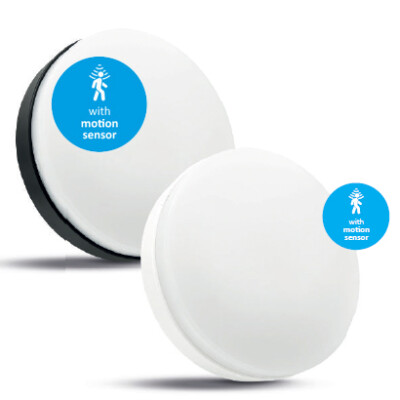
Ceiling lights with motion detector – outdoor lamp with motion detector




Lights with motion detectors are very popular. In addition to classic outdoor lights, these lamps are increasingly being installed and used indoors.
What are the areas of application for ceiling lights and wall lights with motion detectors?
-
Illumination of entrance areas and front doors
- As orientation lights for paths, driveways or covered passageways
- llumination of garages, garage entrances or carports
- installation on the walls of commercial or private properties to provide a greater sense of security/increased safety
- general security lighting
- llumination of areas that are not in constant use, such as small storage rooms, rooms for rubbish bins or access to containers
Where does it make sense to install a ceiling light with motion detector indoors?
-
As a wall light or ceiling light in hallways and corridors of larger apartment buildings
-
Where employees or visitors regularly forget to turn off the light when leaving the room
-
In basement rooms or storage rooms, for example for bicycles
- In work areas where you don't have a free hand to constantly turn the light on and off
- In laundry rooms or other utility rooms
- In larger toilet rooms or washrooms
- In indoor garages or underground car parks
- In large stairwells of apartment buildings or company buildings
What are the advantages of a wall light with motion detector – ceiling light with motion detector?
- High energy savings in rooms or areas that are not in constant use or operation
- Increased sense of security and better orientation in the dark
- Work areas where you don't always have your hands free to switch the light on and off
- High level of protection through deterrence with bright light
- Longer LED service life due to shorter overall operating times
- Sustainable lighting thanks to lower overall CO2 emissions
- Deterrence of unwanted visitors thanks to bright light
Lights with motion detectors. Which sensor is suitable for my application?
There are various types of motion detectors/sensors that are installed in lights. The differences are summarised briefly here
LED ceiling lights with PIR motion detectors
Lights with PIR sensors can be recognised by a fan-shaped hemisphere attached to the outside of the housing. They react to temperature differences caused by infrared differences in the detection area.
Advantages:
- These PIR sensors are relatively inexpensive and very widely used.
Disadvantages of PIR sensors
- They can also be triggered by animals running past or by leaves flying by in autumn. Frequent false alarms are expensive or can lead to trouble with the neighbourhood if the light is constantly turning on.
Wall lights with microwave sensors (HF-MW)
Microwave sensors emit high-frequency electrical waves and react to reflections. A change in frequency is detected as movement. The radiation also passes through thin walls and coverings and can therefore be installed in a concealed manner.
Disadvantage:
- Microwave sensors can also react to movements behind thin walls if there are people there. Microwave sensors are slightly more expensive than lights with PIR sensors.
Combined sensors Motion detectors with daylight sensors
- These lights are very common in outdoor areas. A certain threshold value can also be set for the twilight switch. This means that the sensor only triggers when the brightness/darkness reaches a certain level. When it is bright enough again, the light remains off.
- This saves additional electricity costs, as these sensors are only activated above a certain brightness level.
Wall lights and ceiling lights with basic lighting function
There are areas where it makes sense to set a fixed basic brightness and only switch on full brightness when movement is detected. This is especially true where the basic lighting serves as an orientation aid and is intended to convey a greater sense of security.
Disadvantages of lights with motion detectors
False alarms due to unwanted activation PIR detectors: Can be triggered by animals (cats, dogs), branches in the wind, passing cars (if poorly positioned and with too wide a range) or sudden temperature fluctuations. Even if the detection range is set too far to the side or forward, this can lead to false triggers.
Wandleuchten mit Mikrowellen-Sensoren (HF-MW)
Die Mikrowellen Sensoren senden hochfrequente elektrische Wellen aus und reagieren auf Reflexionen. Bei Veränderung der Frequenz wird dies als Bewegung erkannt. Die Strahlung geht auch durch dünne Wände und Abdeckung und kann deswegen auch versteckt installiert werden.
Nachteil: Die Mikrowellen Sensoren können auch auf Bewegungen hinter dünnen Wänden reagieren, wenn sich dort Personen aufhalten. Preislich sind die Mikrowellen-Sensoren etwas teurer als Leuchten mit PIR-Sensoren.
Kombinierte Sensoren Bewegungsmelder mit Tageslicht-Sensoren
Diese Leuchten finden man sehr häufig im Außenbereich. Der Dämmerungsschalter kann auch einen gewissen Schwellenwert festgelegt werden. Das heißt erst ab einer gewissen Helligkeit / Dunkelheit löst der Sensor aus. Wenn es wieder hell genug ist bleibt das Licht immer aus.
Das spart zusätzlich Stromkosten, da diese Sensoren nur ab einer bestimmten Helligkeit aktiv geschaltet werden.
Wandleuchten und Deckenleuchten mit Grundlichtfunktion
Es gibt Bereiche da macht es Sinn, eine feste Grundhelligkeit einzustellen und erst ab der Erfassung einer Bewegung die volle Helligkeit zuzuschalten. Speziell dort wo das Grundlicht als Orientierungshilfe dient und ein erhöhtes Sicherheitsgefühl vermitteln soll.
Nachteile von Leuchten mit Bewegungsmelder
-
False alarms caused by unwanted activation PIR detectors: Can be triggered by animals (cats, dogs), branches in the wind, passing cars (if poorly positioned and with too wide a range) or sudden temperature fluctuations. If the detection range is set too wide to the side or front, this can also lead to false alarms.
- HF/MW detectors: Can be triggered by movements behind thin walls or by neighbours if the sensitivity is set too high.
-
Delay when switching: There is a minimal delay between the detection of movement and the switching on of the light. However, this is usually very short and hardly noticeable. At higher speeds, e.g. in car parks due to moving cars, this can be a problem.
-
Switching off too early: Incorrectly set follow-up times cause the light to go out when you are no longer moving in the detection area. This can be annoying and lead to uncertainty.
-
Greater effort due to more complex settings: Compared to a simple luminaire, the installation of a motion detector often requires additional cables or more precise alignment. Setting the range, sensitivity and follow-up time requires more effort and a certain amount of experience. In some cases, multiple adjustments are necessary to achieve a perfect result.
- Higher acquisition costs: Luminaires with integrated motion detectors are usually more expensive than comparable luminaires without this function.
- Limited flexibility: It is no longer possible to switch the light manually. When the motion detector is active, the switching process is completely left to the light.

